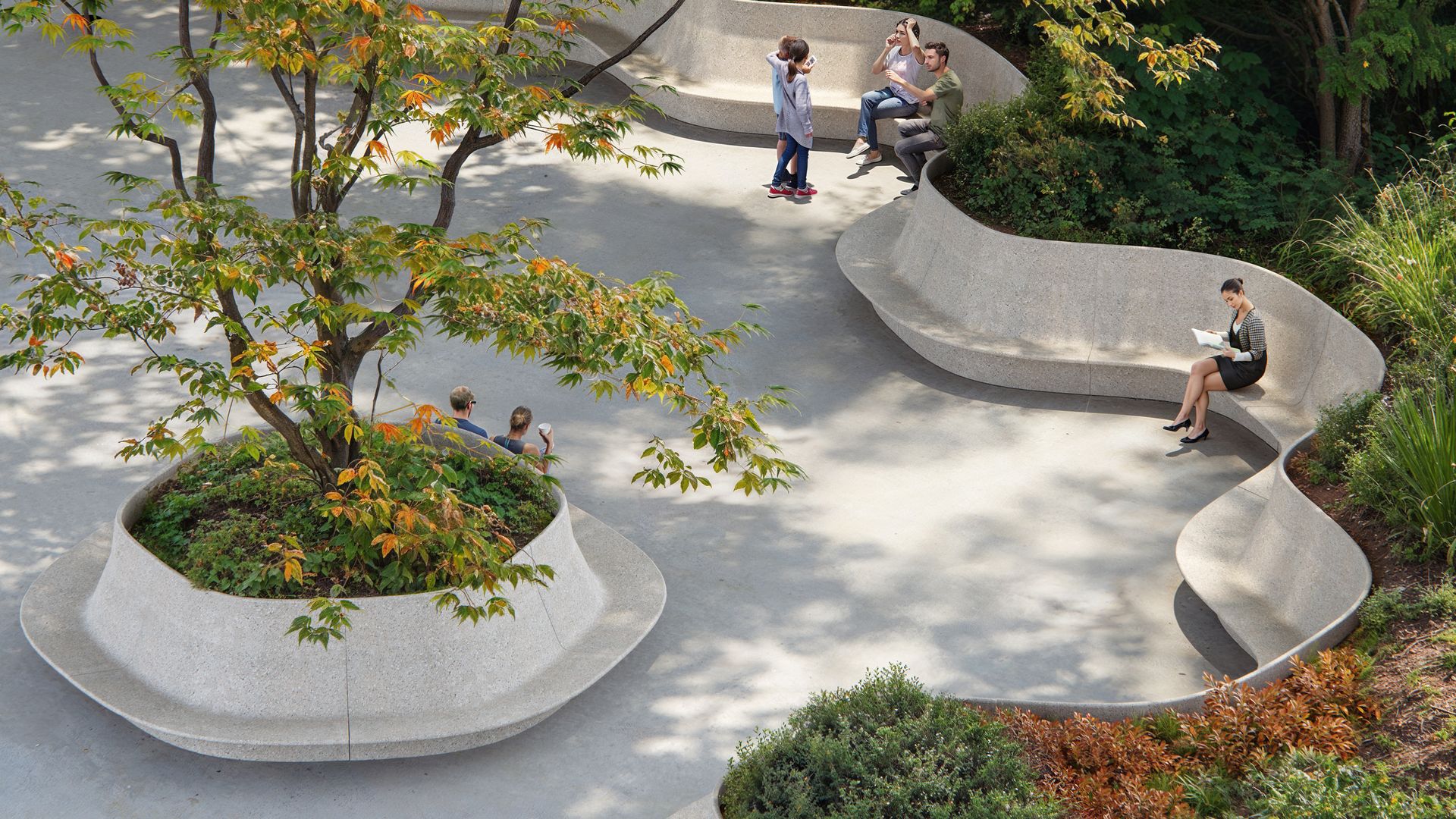Garden, Patio, or Street Furniture?
What exactly is the difference and how do you choose the right outdoor furniture for each environment?
ContactGarden, Patio, or Street Furniture ?
What's the Difference and why ?
A sun lounger in the garden, a café chair on a bustling high street, or a robust bench at a tram stop. At first glance, outdoor furniture might look similar, but the differences are fundamental. Whether you're a homeowner seeking comfort in your garden, a hospitality manager relying on a flexible terrace setup, or an urban planner looking for durable solutions for the public realm: the right choice always starts with the specific place where the outdoor furniture will be used.
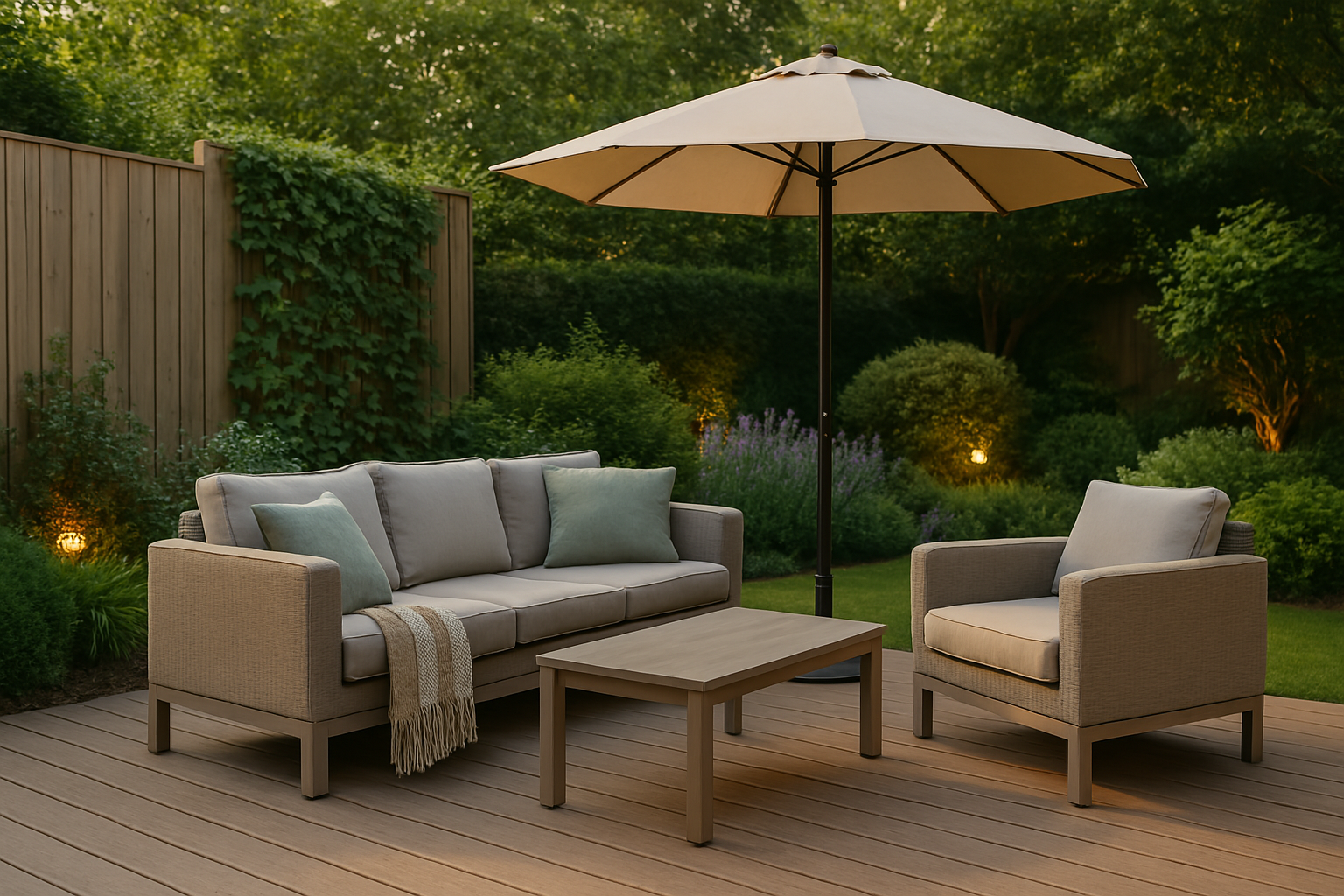
This article explores the essential difference between garden furniture, patio furniture, and street furniture – also known as public furniture or urban furniture. We explain how each type adapts to its environment and how that context determines crucial factors like lifespan, maintenance, anchoring needs, ergonomics, and visual appeal.
1. The Impact of Location on Outdoor Furniture
Outdoor furniture is not a one-size-fits-all solution. What works perfectly in a sheltered private garden is often unsuitable for a busy city square or an intensively used commercial terrace. Each location places different demands on comfort, durability, safety, and ease of use.
In a garden setting, atmosphere and personal relaxation are key. On a hospitality terrace, practicality and efficiency take precedence: the furniture is used intensively and often needs to be moved or stored. And in the public space? There, every element of street furniture must withstand all weather conditions, years of intensive use, and potential vandalism.
The context of use, therefore, dictates everything: from material choice and anchoring methods to maintenance requirements and ergonomic design..
2. Use Locations and Their Specific Needs
Private Garden – Comfort and Style for Personal Use
Picture a comfortable lounge sofa under a pergola, a dining set gleaming in the summer sun, or a lounger by the pool. In a private garden, furniture acts as an extension of the home; it's all about atmosphere, personal taste, and comfort. Garden furniture – also referred to as residential outdoor furniture or private garden seating – is used in domestic environments. Intensive use is less common here, and weather exposure is often limited thanks to shelters or seasonal storage.
Hospitality Terraces and Commercial Outdoor Zones – Intensive Use, Maximum Flexibility
A stackable chair on a busy city terrace, folding tables quickly rearranged after closing time, or a sturdy bar stool at an outdoor bar. In professional contexts like hospitality venues, cafés, restaurants, and retail areas, outdoor furniture – often called commercial outdoor furniture or hospitality furniture – sees very intensive use. It must therefore be wear-resistant, robust, lightweight, and exceptionally easy to maintain. Operators often choose materials like aluminium or plastic with smooth surfaces, as they are easy to clean and resistant to heavy use. Flexibility is essential: furniture must be quickly rearranged or stored.
Semi-Public Spaces – Functional and Representative
Examples include benches in a hospital waiting area, seating in an airport terminal, or picnic tables on a school campus. Semi-public zones are managed by an organisation but are accessible to a wide audience. The furniture here must be both functional and durable, while also contributing to the space's image and experience. Think of ergonomic comfort for people waiting, ease of maintenance, and a design that matches the identity of the place (e.g., a university, healthcare facility, or corporate campus).
Public Spaces – Long-Term Durability and Accessibility
A bench in a town square, a litter bin at a bus stop, or a handrail near a ramp for wheelchair users. In the public realm, the various elements of street furniture or urban furniture are permanently present and continuously exposed to all weather conditions, intensive use, and potential vandalism. This type of public furniture (or site furniture) is manufactured from extremely robust materials such as (reinforced) concrete, galvanized steel, cast iron, or durable hardwood (e.g., FSC-certified). Anchoring into the ground is standard practice to ensure stability, safety, and theft prevention. Inclusive accessibility and safety are not optional extras here; they are essential design criteria. Public furniture must last for decades without compromising on comfort, functionality, or aesthetic value.
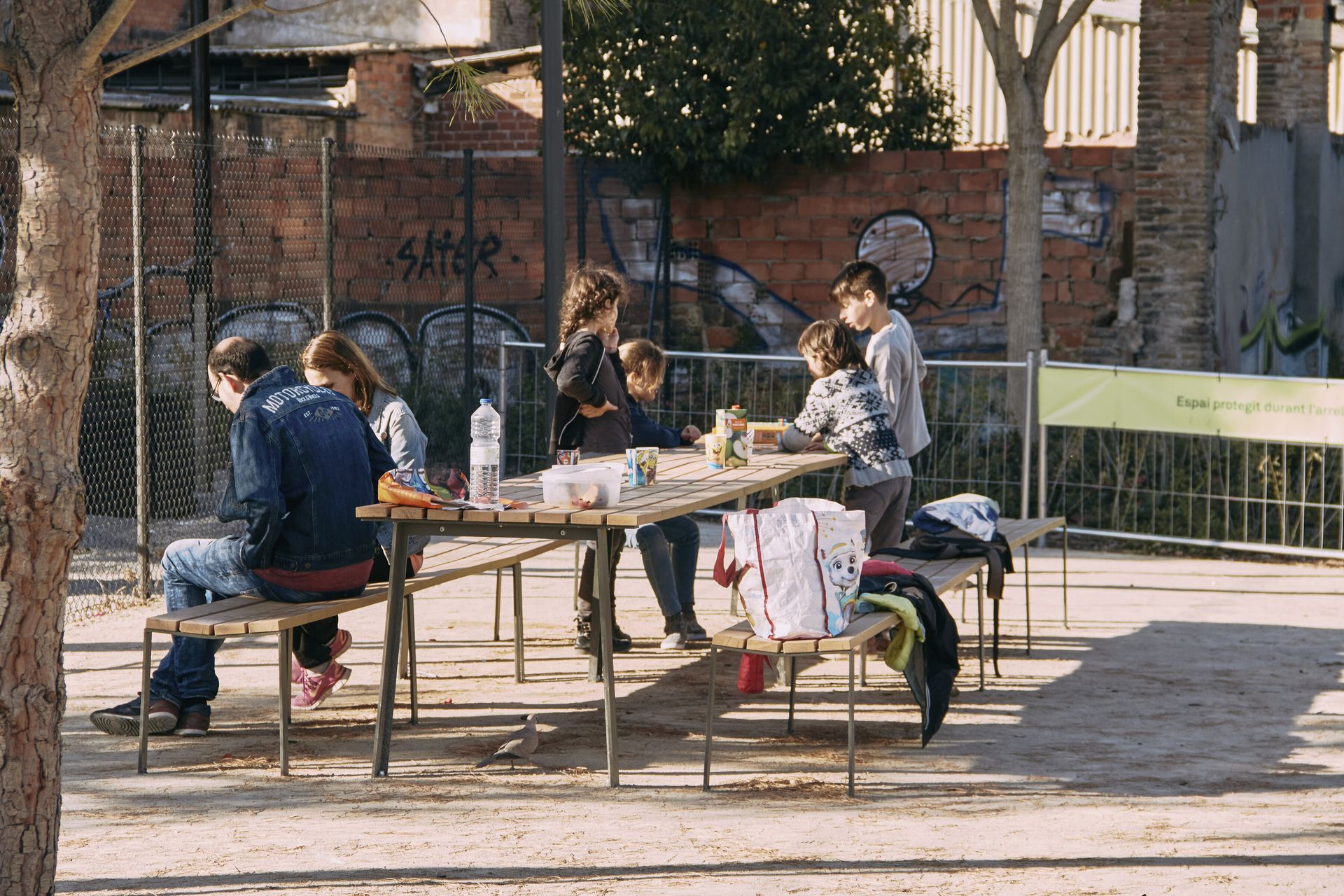
3. What is Garden Furniture ?
Garden furniture, also known as residential outdoor furniture, is designed for comfort, style, and personal use in private outdoor settings like backyards, patios, or roof terraces. A typical application is a plush lounge set under a pergola or a sun lounger by the pool, often complemented by decorative cushions, throws, or ambient lighting. The focus is on personal experience, relaxation, and aesthetics, rather than functional robustness for public use.
Common materials include wood, aluminium, or synthetic rattan-look plastic, chosen for their visual appeal and suitability for various garden styles. Because garden furniture is often sheltered or stored during winter, requirements for weather resistance and anchoring are limited. Ergonomics are often a matter of personal preference, and accessibility usually plays a minor role unless specifically chosen for adapted models.
4. What is Patio Furniture ?
Patio furniture – also referred to as hospitality outdoor furniture or commercial-grade furniture – is used intensively in high-traffic commercial environments such as cafés, restaurants, shopping centres, and food courts. Imagine a busy terrace where chairs are set up daily, rearranged frequently, and stacked away again in the evening. Here, each piece must withstand intensive use, various weather conditions, and frequent cleaning. Typical examples include stackable chairs, folding tables, bar stools, and corresponding parasol bases.
Materials like aluminium, galvanized steel, or hardwood combine strength with relatively light weight for movability. Anchoring is not standard, but the furniture is often secured outside opening hours, for instance, by chaining it together or storing it indoors. In some situations, like permanent terraces in semi-public zones, partial anchoring or heavier furniture types might be advisable to prevent unwanted movement. Design is important and often aligned with the brand's visual identity, such as sleek metal chairs for a minimalist coffee chain or natural materials for a beach bar.
5. What is Street Furniture ?
Street furniture – also known as public furniture, park furniture, urban furniture, or site furniture – encompasses all fixed outdoor furnishings permanently present in the public space. Think of benches in village squares, picnic tables in parks, bicycle racks near a station, or leaning posts along pedestrian zones. This type of furniture forms an integral part of the urban or rural infrastructure and is used intensively daily by a broad and diverse public.
The materials used are in a different league: reinforced concrete, galvanized steel, corten steel, cast iron, or FSC-certified hardwood ensure maximum lifespan and minimal wear and tear. Street furniture is anchored to the ground as standard to prevent theft, vandalism, and unwanted displacement.
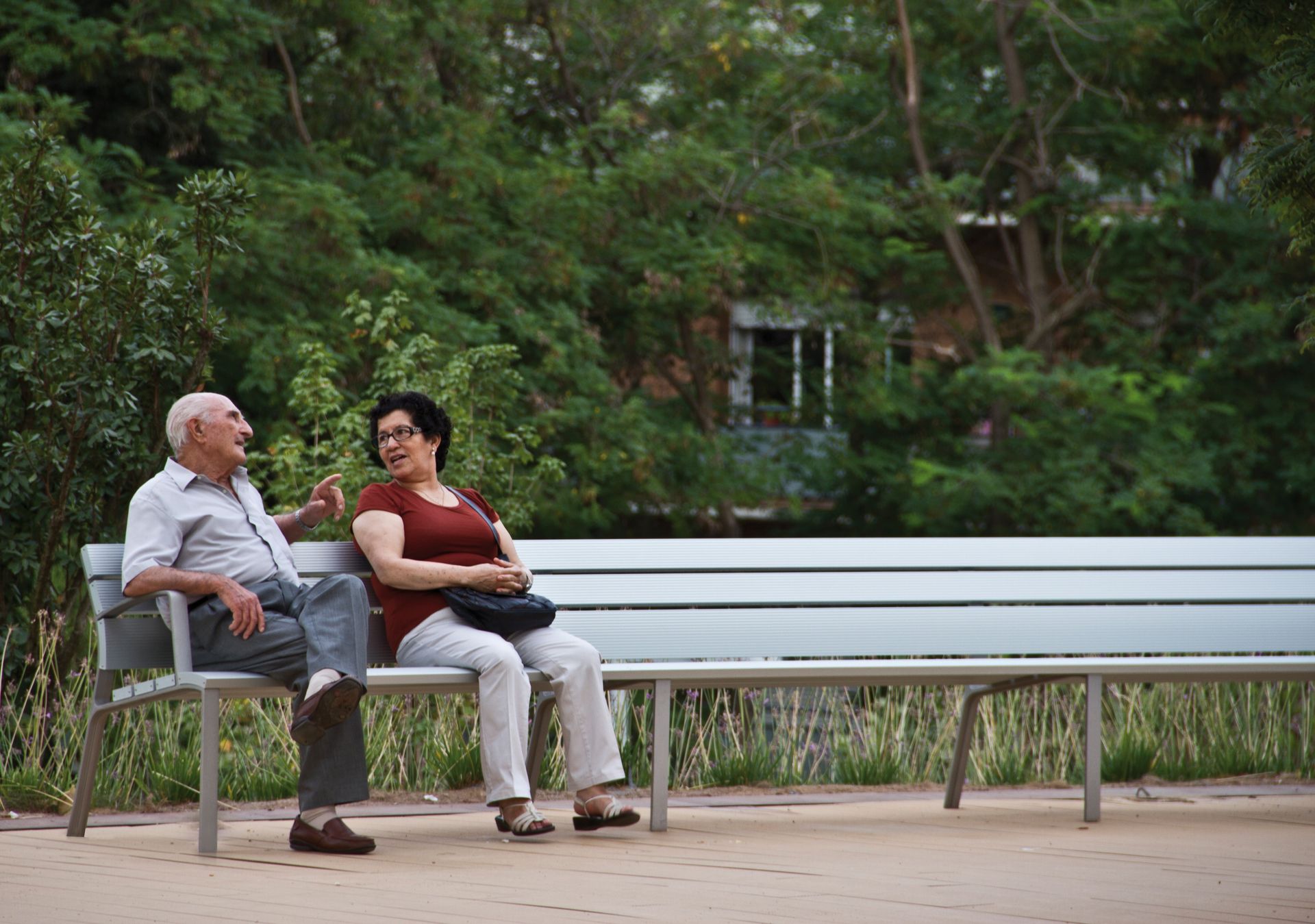
A crucial difference from other outdoor furniture is that public furniture is designed entirely based on principles of universal accessibility and long-term sustainability. It must be usable by everyone: children, the elderly, people with disabilities, and wheelchair users. This translates into universal seat heights, tactile finishes, supportive armrests, and strategic placement relative to pathways and mobility hubs.
Design plays a dual role: it must be functional and visually harmonize with the surroundings. After all, street furniture contributes to the character and identity of a city, district, or neighbourhood and must be both durable and recognizable.
6. What are the Key Differences between Garden, Patio, and Street Furniture?
Although garden furniture, patio furniture, and street furniture all fall under the umbrella of outdoor furniture, their differences are fundamental and directly linked to the environment of use.
- Garden Furniture: Designed for private gardens, patios, and enclosed outdoor spaces. Often seasonal use, by a small group. Aesthetics and comfort are paramount. Materials chosen for style (wood, plastic, powder-coated steel). Anchoring rarely needed, accessibility optional.
- Patio Furniture: For commercial contexts (hospitality, retail). Higher frequency of use, must withstand daily, intensive use by a changing public. Flexibility (stackable, movable) is important. Materials are sturdy and easy to maintain (aluminium, hardwood, smooth plastic). Anchoring sometimes used, but not standard. Design often linked to brand identity.
- Street Furniture (Public/Urban/Site Furniture): Permanently installed in the public realm (squares, parks, stops). Must withstand all weather conditions, vandalism, and very long-term, intensive use. Made from extremely durable materials (concrete, corten steel, galvanized steel). Always anchored. Designed for universal ergonomics and accessibility (armrests, adapted heights). Higher initial investment, but longer lifespan and lower maintenance costs.
The difference, therefore, lies not just in form or material, but primarily in the interplay between location, purpose, durability, ergonomics, accessibility, and maintenance..
Summary Table: Garden vs. Patio vs. Street Furniture :
| Feature / Characteristic | Garden Furniture | Patio Furniture | Street Furniture |
| Usage Location / Setting | Private garden | Hospitality, commercial outdoor areas | Public space, Semi-Public Spaces, mobility hubs, parks |
| Usage Frequency | Occasional | Daily, average | Continuous, intensive |
| Materials | Wood, plastic, powder-coated steel | Aluminum, plastic, hardwood | Concrete, corten steel, galvanized steel |
| Anchoring | Not necessary | Sometimes, temporary | Permanent and essential |
| Durability | Moderate to good | Good | Very high, designed for decades of use |
| Maintenance | User determines | Frequent, easy to clean | Minimal, efficient |
| Accessibility & Ergonomics | Optional | Functional | Mandatory, universal design |
| Price Level | Low to medium | Medium / Average | High, but a sustainable investment |
| Aesthetic Freedom | High / Large | Moderate, aligned with brand identity | Dependent on urban context |
7. Frequently Asked Questions about Outdoor Furniture
Do you still have specific questions about garden, patio, or street furniture after reading this article? Below you'll find answers to frequently asked questions, based on our expertise. We cover topics like the distinction between park and street furniture, the lifespan of different types, and making the right choice for public or semi-public spaces.
Can't find your answer below? Feel free to contact us for personal advice.
An Overview of the related Questions :
7.1. What are the main differences between garden, patio, and street furniture ?
7.2. Can patio furniture be used in a public space ?
7.3. What is the difference between park furniture and street furniture ?
7.4. What are examples of semi-public spaces ?
7.5. Is garden furniture suitable for intensive use ?
7.6. How does street furniture contribute to an inclusive and accessible outdoor space ?
7.8. What role does design play in choosing street or urban furniture ?
7.9. What is the average lifespan of street furniture ?
7.10. Are there sustainable or circular alternatives to classic street furniture ?
7.1. What are the main differences between garden, patio, and street furniture ?
Street furniture is specifically designed for long-term, intensive use in unpredictable and often unsupervised environments. It must withstand extreme weather conditions, daily use by potentially thousands of people, and vandalism. This requires exceptionally durable materials like galvanized steel, (reinforced) concrete, or certified hardwood. Furthermore, street furniture is always securely anchored to the ground.
The design must also comply with inclusive ergonomic guidelines for universal accessibility. All these factors make street furniture more expensive to purchase than garden or patio furniture, but it results in a significantly longer lifespan and a lower total cost of ownership.
7.2. Can patio furniture be used in a public space ?
Patio furniture is primarily intended for controlled and semi-public environments, such as hospitality terraces or commercial zones. Although it is often sturdy and easy to maintain, it typically lacks the structural robustness, vandal resistance, and necessary anchoring options required for permanent installation in fully public spaces like parks or squares.
Temporary use, for example during events, might be possible, but for permanent setups, specific street furniture remains the safest and most durable choice.
7.3. What is the difference between park furniture and street furniture ?
Both park furniture and street furniture fall under the category of 'public furniture' and share characteristics like durability and anchoring. The difference lies mainly in function and the intended user experience. Street furniture is often placed in high-traffic transit locations (bus stops, squares, shopping streets) where people stay briefly.
The design focuses on functionality, robustness, and flow. Park furniture, conversely, is intended for longer periods of rest in green or recreational environments. Think of ergonomically shaped benches with backrests and armrests, picnic tables, or loungers. Comfort and relaxation are more central here, naturally without losing sight of the demands for durability and ease of maintenance.
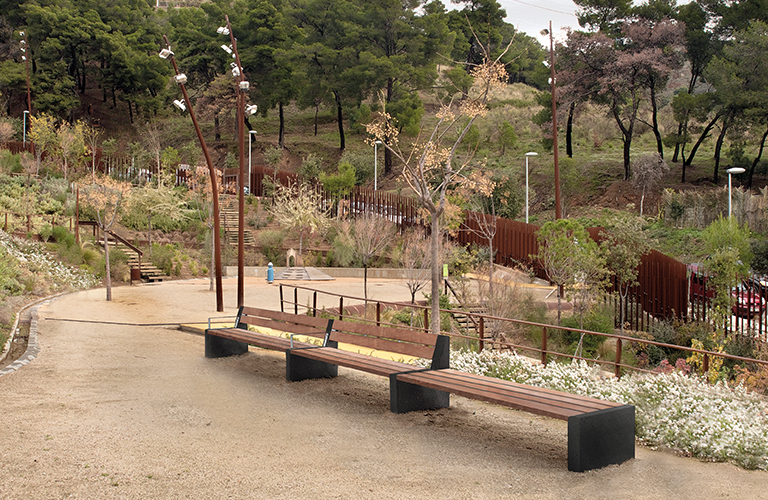
7.4. What are examples of semi-public spaces ?
Semi-public spaces are environments freely accessible to the public but managed by a specific organization or institution. Examples include train stations, airports, hospitals, colleges, university campuses, and indoor shopping centres.
These places combine high visitor numbers with a degree of supervision and management. The furniture here must be functional and robust, but also aesthetically consistent with the managing entity's identity (e.g., comfortable waiting areas in stations, social seating areas on campuses).
7.5. Is garden furniture suitable for intensive use ?
Garden furniture is designed for occasional, personal use in a sheltered setting. It is not intended for continuous exposure to the elements, nor for years of intensive use without specific maintenance. The construction is often lighter, materials more susceptible to wear, and anchoring is rarely provided.
For situations involving daily intensive use by many people (squares, terraces, public zones), garden furniture is therefore unsuitable and can lead to rapid deterioration, high maintenance costs, and unsafe conditions.
7.6. How does street furniture contribute to an inclusive and accessible outdoor space ?
Street furniture plays a key role in creating public spaces that are comfortable and usable for everyone, regardless of age, mobility, or disability. Inclusive design considers diverse users: wheelchair users, the elderly, children, visually impaired people. This translates into practical features such as correct seat heights, backrests and armrests for support, tactile elements, and thoughtful placement along logical routes. This way, the outdoor space becomes not only functional but also socially equitable and welcoming.
Read more in our articles on ergonomics and inclusive public spaces :
- artikel over ergonomie in straatmeubilair
7.7. What kind of street furniture is suitable for semi-public spaces like stations, campuses, or hospitals ?
Specific requirements apply in semi-public environments. Comfort is often as important here as robustness. Think of benches providing good support for those waiting, inviting rest points, or modular seating elements that can be flexibly arranged.
The design must align with the place's identity: calming and reliable in a hospital, inspiring and informal on a campus. The furniture must contribute to the user's experience, safety, and orientation. A combination of aesthetics, ergonomics, and ease of maintenance is crucial here.
7.8. What role does design play in choosing street or urban furniture ?
Design is essential for street furniture. It not only determines the appearance but also influences how people use and experience the space. A well-designed bench invites pausing, an aesthetically pleasing bin encourages correct disposal, and a recognizable design language strengthens a place's identity.
In urban projects, urban furniture is increasingly seen as an extension of the architectural vision. Design must be functional, durable, ergonomic, accessible, and aesthetically integrated into the broader context. Form follows function, but in the public realm, both also follow the place and its users.
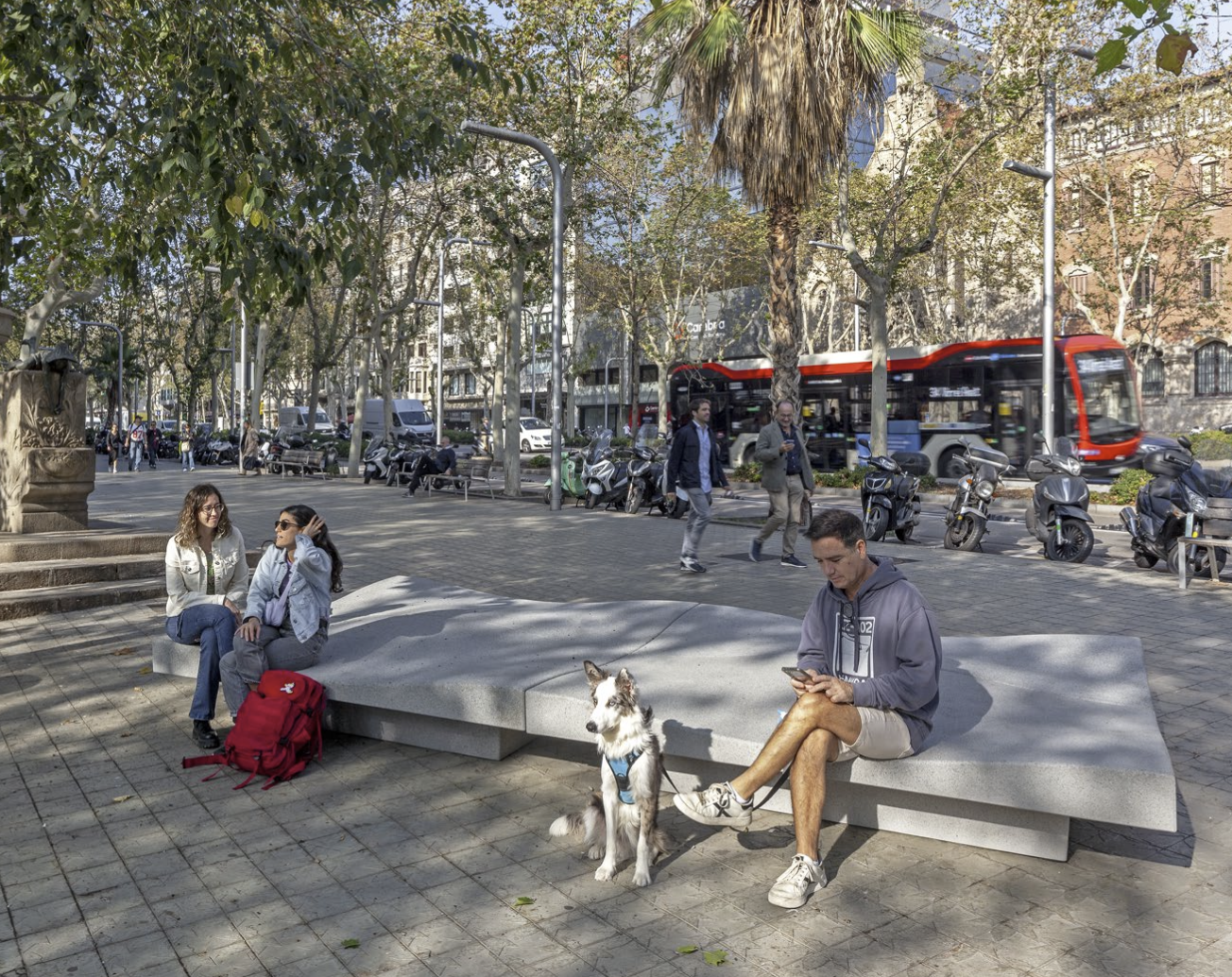
7.9. What is the average lifespan of street furniture ?
The lifespan depends on materials, usage, and maintenance. High-quality street furniture, correctly installed and maintained, typically lasts 20 to 30 years, sometimes even longer. Materials like concrete, corten steel, galvanized steel, and tropical hardwood require relatively little maintenance and retain their structure and appearance for a long time, even with permanent exposure to weather and intensive use.
This durability is essential and translates into lower long-term replacement and maintenance costs (total cost of ownership).
7.10. Are there sustainable or circular alternatives to classic street furniture ?
Absolutely. Sustainable and circular solutions are strongly emerging. More and more street furniture is being produced from recycled materials such as plastic granulate, reclaimed steel, or concrete granulate. Manufacturers offer modular systems where parts can be easily replaced or reused, extending the lifespan.
Take-back programs, where discarded furniture re-enters the production cycle, also fit within circular economy principles. For cities, municipalities, and organizations committed to sustainability, these are logical, future-oriented choices that reduce the ecological footprint and demonstrate social commitment.
8. Conclusion: The Right Choice for Every Outdoor Space
Garden furniture, patio furniture, and street furniture each fulfill their own indispensable role in our outdoor spaces. They differ fundamentally in how they respond to their environment: a private garden calls for comfort and atmosphere, a hospitality terrace demands flexibility and ease of maintenance, and the public realm requires robustness, inclusivity, and long-term durability.
Choosing the right outdoor furniture is therefore much more than an aesthetic preference. It is a thoughtful, strategic consideration of factors such as frequency of use, location, weather exposure, maintenance requirements, lifespan, and the specific needs of the users. Understanding this context properly means making choices that not only last longer and function better but also genuinely add value for the users and the environment.
9. Need Advice for Your Project ?
Do you have specific questions about furnishing your outdoor space? Whether you are a professional (hospitality, government, project developer) looking for durable and functional street furniture or a homeowner wanting to better understand the differences, our team is ready to help.
Contact Servibo today for obligation-free advice tailored to your project.
